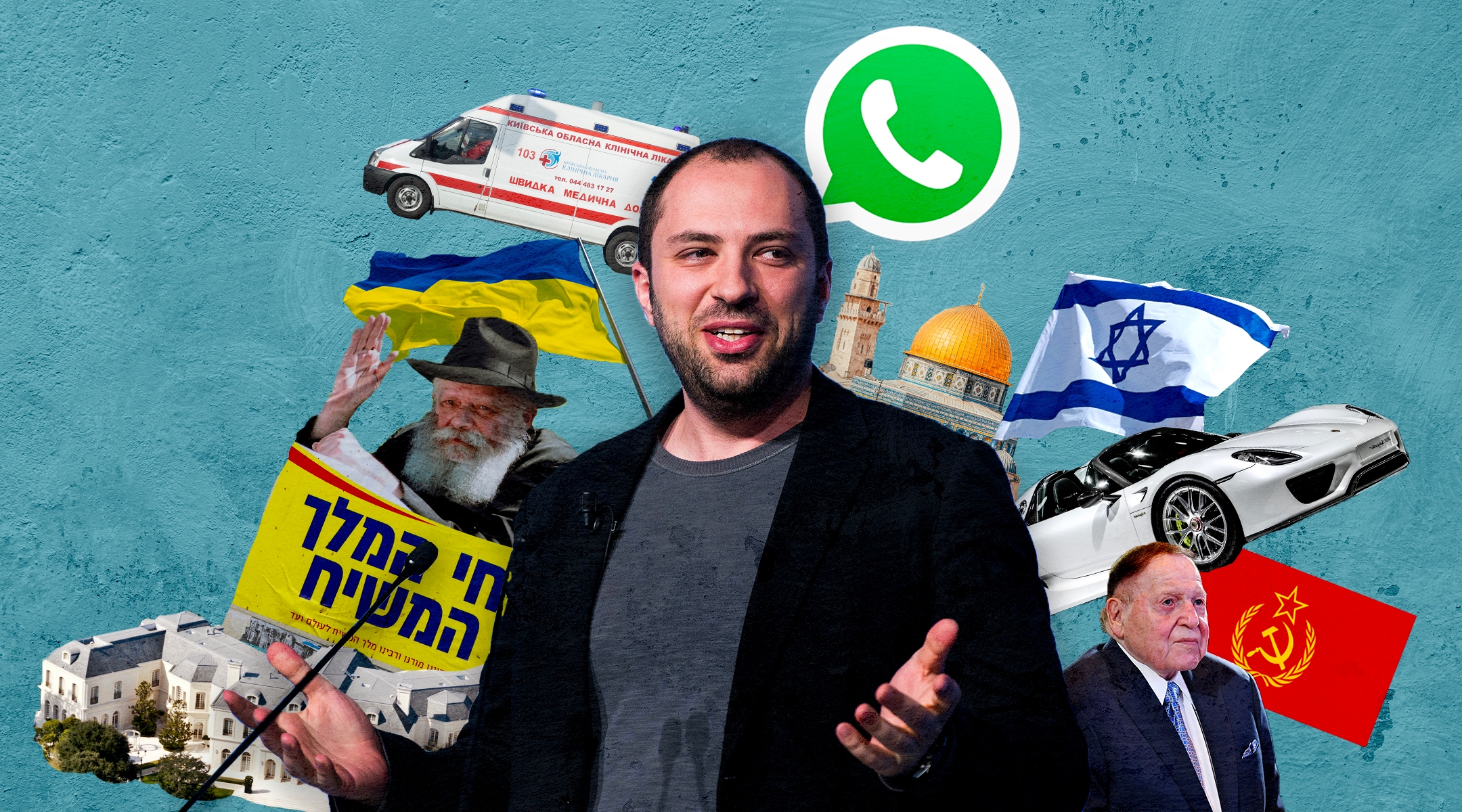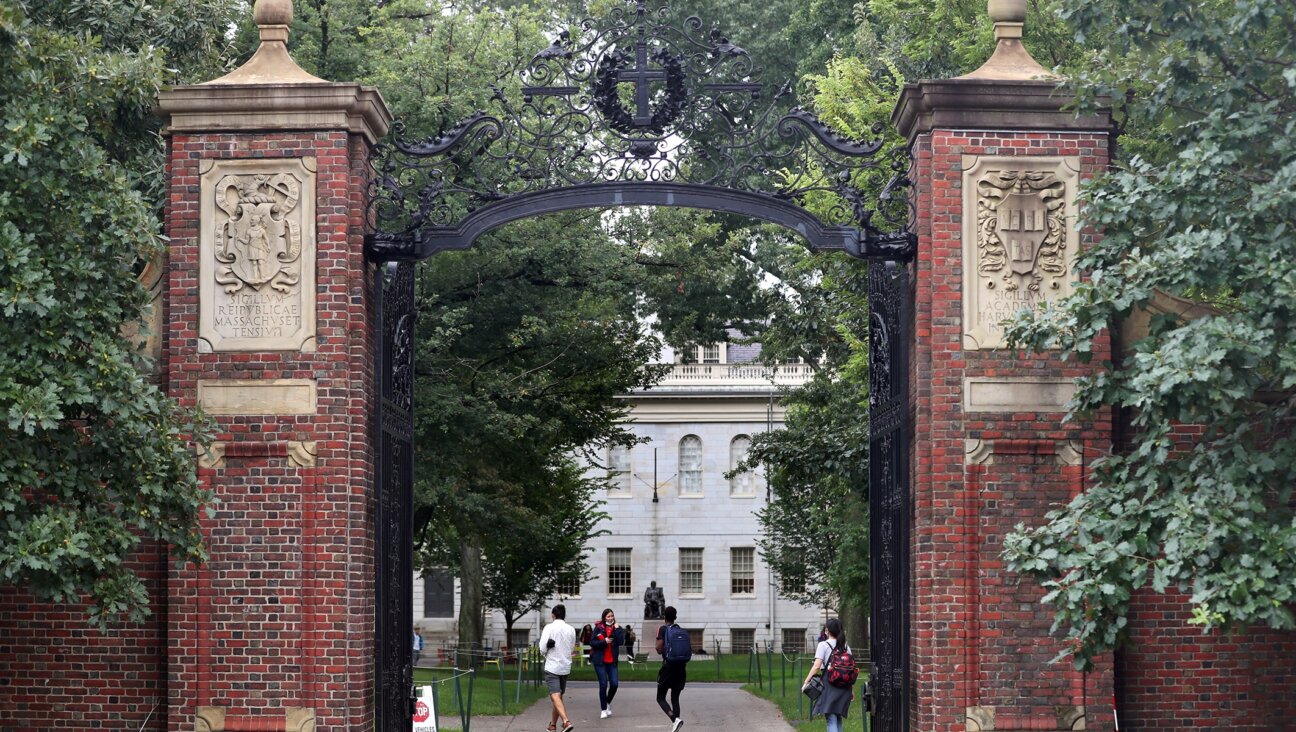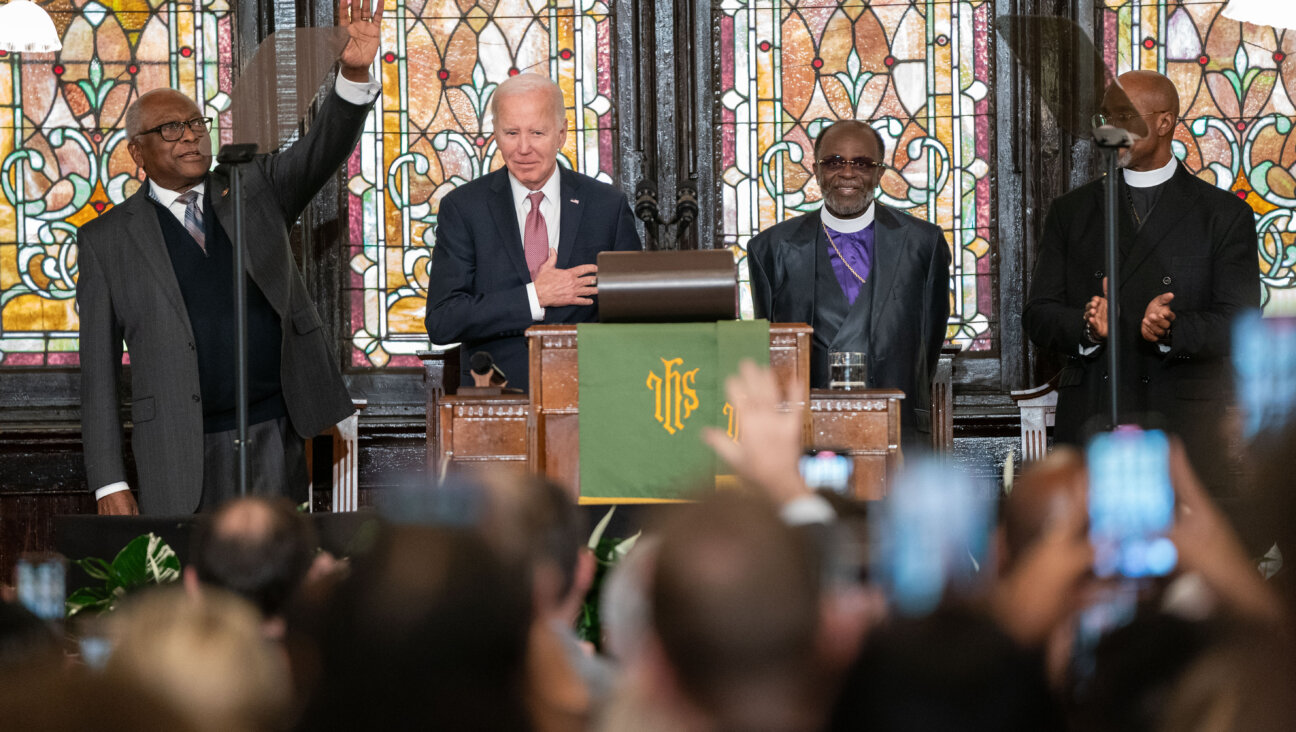WhatsApp’s reclusive founder has quietly become a megadonor to Jewish causes
Billionaire Californian Jan Koum gives to Chabad, pro-Israel causes and Jewish relief efforts in his native Ukraine.

Designed by Grace Yagel with images from Getty Images and Wikimedia Commons.
(JTA) – The fighting in Ukraine has been called “a WhatsApp war” amid widespread reliance on messaging apps by journalists, soldiers and ordinary civilians, and their central role in spreading propaganda.
Meanwhile, WhatsApp’s inventor, a Ukrainian-born Jew whose creation made him one of the wealthiest people in the world, has kept conspicuously quiet throughout the conflict. Jan Koum, who controls a multi-billion-dollar charitable foundation, has not uttered a public word even as many other wealthy Ukrainians and Russians announce donations toward humanitarian relief efforts.
But based on an examination of tax returns filed by Koum’s foundation before the war, the publicity-shy WhatsApp founder, who arrived in California as a teenager, is more entwined than meets the eye with the events rocking the country he left behind as a 16-year-old. His donations, only a sliver of which have been previously reported, include tens of millions of dollars to Jewish organizations now involved in relief efforts in Eastern Europe.
For example, from 2019 to 2020, the latest year for which there is a tax return, the Koum Family Foundation donated about $17 million to the European Jewish Association, an organization headquartered in Brussels that launched a campaign in March to provide housing, food and clothing to refugees from the war. Nearly all of the group’s 2019 budget came from Koum.
With $10.6 million in gifts over that same period, Koum’s foundation is also one of the most significant donors to another group involved in relief efforts: the Federation of Jewish Communities of the CIS. The group, whose name refers to the Commonwealth of Independent States, an association of former Soviet territories, announced the establishment of an ambulance fleet to evacuate patients throughout Ukraine.
It is unknown whether Koum continued to make donations in 2021 and afterward because his foundation and all of the past grantees contacted by the Jewish Telegraphic Agency have either ignored requests for comment or declined to speak on the record. JTA contacted more than a dozen of the nonprofits, several of which said they were prohibited from publicly acknowledging Koum’s giving as a condition of their gift.
Due to the secrecy marking his charitable giving, as well as his personal life, Koum’s profile as a philanthropist over the past several years has gone almost unnoticed. However, tax returns reveal that Koum, with a fortune estimated between $9.8 billion and $13.7 billion, has quietly become one of the largest donors to Jewish causes in the world.
His foundation gave nearly $140 million from 2019 to 2020 to about 70 Jewish charities working in the United States, Eastern Europe and Israel. That’s on par with the rate of giving by the biggest and best-known donors in the Jewish world, such as Tulsa-based Charles and Lynn Schusterman Family Philanthropies, whose imprint is on hundreds of Jewish organizations, including JTA.
At this level of giving, Koum has an outsized impact on Jewish communal life but without any of the public awareness that often accompanies major philanthropy.
That Koum has been able to operate under the radar isn’t surprising to Lila Corwin Berman, a professor of American Jewish history at Temple University, who writes about philanthropy.
“We have a system in place that guards the privacy of donors and requires minimal forms of reporting and oversight,” she said. “Only by knowing the Koum name can I excavate tax records to see the list of grantees — and this assumes that the foundation disburses all of its gifts directly, without using community foundations as pass-throughs. The rules as they exist appear to value the donor’s privacy and autonomy above the public’s knowledge.”
Transparency about funding should be particularly important when it comes to Jewish nonprofits because of their goal of “stitchi[ing] together the broad diversity of Jewish life,” according to Corwin Berman.
“The Jewish public should care because such a large funder can inevitably sculpt and set communal priorities,” she said.
An analysis of the Koum foundation’s tax returns reflects that, more than any other cause, Koum gives to nonprofits affiliated with Chabad-Lubavitch, the international and growing Hasidic Orthodox Jewish movement with origins in Eastern Europe. Chabad, which provides religious and humanitarian services in far-flung Jewish communities, runs an array of current activities in the region.
The European Jewish Association, for example, is led by a Chabad-affiliated rabbi, and the Federation of Jewish Communities of the CIS counts Berel Lazar, a major Chabad rabbi who leads Russia’s Jewish community, as a director. Koum has also given to several Chabad congregations in California and other organs of the movement.
One of Koum’s top Chabad-linked grantees is a nonprofit known as the Jewish Community Center of Moscow, whose address leads to a brown-brick residential building in Brooklyn, a few minutes’ walk away from Chabad’s global headquarters in Crown Heights.
The organization has no website, and since it is classified as a religious organization, the Jewish Community Center of Moscow is exempt from filing paperwork detailing its mission, leadership or financial activity, as is required of other types of nonprofits. But a review of IRS records suggests that a typical donation to the organization ranged from $15,000-$55,000 for a number of years until, in 2019, the pattern changed. That’s when the Koum foundation gave the nonprofit $3.3 million. In 2020, it gave $5.7 million.
No one reached by JTA would speak on the record about Koum’s motivations, but Chabad is popular among Jews who grew up in the former Soviet Union.
“In their outreach, mode of operations and philosophy Chabad have been very welcoming and helpful to Russian-speaking Jews,” said Misha Galperin, a consultant to donors and charities and the president of the National Museum of American Jewish History, who grew up in the Soviet Union.
Galperin said this affinity exists despite the lack of religious observance among many Jews from the former Soviet Union.
“Most Jews from the former Soviet Union are not observant, and they’re not particularly interested in following the commandments in the way that Chabad understands them,” he said. “But they [Chabad] look like Jews — in other religions, you might think of priests and imams as having a uniform. In Judaism, it’s [Chabad] Lubavitch and other Hasidim who have a look. So many Russian-speaking Jews think of Chabad as ‘my synagogue that I won’t go to.’”
Joshua Tapper, a historian of Soviet Jewry who has written about Chabad’s success with this demographic, said the movement offers an appealing message for people whose Jewish identity was suppressed by Soviet authorities.
“Chabad’s rhetoric is that ‘our movement was born here, we survived many decades underground, in the Soviet wilderness, getting by on our wits and our religious fervor and belief in God, and now we’ve reclaimed our rightful place as the leader of Russian-speaking Jewry,’” said Tapper, who is a graduate student at Stanford University and former reporter for JTA.
Koum’s donations are not limited to Chabad or even to religious groups. He is also a major supporter of the Israeli healthcare system with gifts to Hadassah and to the U.S. fundraising affiliates of various Israeli hospitals.
He also donates millions to Jewish institutions in the San Francisco Bay Area, such as the Oshman Family Jewish Community Center in Silicon Valley. Tax records also reveal that he is the previously anonymous donor behind a new $3.5 million center for the Russian-speaking Jewish community of San Francisco.
At least a few of his donations reflect his right-wing political views on Israel. Donations of $600,000 went to the Maccabee Task Force Foundation, an organization founded by the late Republican megadonor Sheldon Adelson to support Israel advocacy on college campuses. The foundation has also given $6 million to Friends of Ir David, the American fundraising arm of Elad, a group trying to expand Jewish settlement in parts of largely Arab East Jerusalem, and $175,000 to the Central Fund of Israel, which has been accused of supporting violent extremists in Israel.
The Koum foundation’s only major non-Jewish gifts have gone to two universities: $1 million to Fordham in 2020 and some $41 million to Stanford since 2017. His affinity for these institutions is somewhat surprising considering that the only university Koum has attended is San Jose State University, from which he dropped out to focus on his first major job in tech, at Yahoo.
Koum’s story is a real-life rags-to-riches tale of an immigrant who came to the United States with nothing, sought to improve his lot, worked hard and became fabulously wealthy as he developed a product used by billions of people every day. Since he has granted very few interviews, most of what’s known about his life can be gleaned from only a few sources, most notably a profile by Forbes penned as he and his partners sold WhatsApp to Facebook for $22 billion in 2014.
A previously unreported lawsuit filed against Koum in Los Angeles by a former employee at one of his mega-mansions last year helps fill in the years since the acquisition and following Koum’s departure from Facebook in 2018. It reflects an account of Koum as a hoarder of some of the most expensive homes in California and a zealous protector of his own privacy.
Koum was raised on the outskirts of Kyiv in the town Fastiv, which happened to be shelled by Russian forces early in the current war.
In 1992, after the fall of the Soviet Union and amid political turmoil and antisemitic tension, a teen-aged Koum his mother immigrated to Mountain View, California, and began living in a two-bedroom apartment made available through public assistance. His father stayed behind and died in 1997.
They relied on food stamps as his mom earned money babysitting and Koum swept the floors of a grocery store for work. His mom was soon diagnosed with cancer, entitling the family to disability payments for a while. She died in 2000, leaving Koum an orphan at 24.
His self-education in computer networking brought him into contact with the emerging startup world in Silicon Valley, and he eventually went to work for Yahoo with his future WhatsApp co-founder Brian Acton. The two bonded over their shared no-nonsense attitude. “Neither of us has an ability to bullshit,” Acton told Forbes.
The duo left Yahoo in 2007 to take a sabbatical, which was spent traveling South America and playing Ultimate Frisbee. In a twist that would prove ironic, they each applied to work at Facebook but were rejected.
In 2009, the iPhone had only recently been launched, and the App Store was only seven months old. Koum saw opportunity in this new mobile frontier and he began brainstorming ideas with members of the Russian-speaking community of San Jose. Forbes describes long conversations about WhatsApp over tea between Koum and Alex Fishman, a graduate of the Technion-Israel Institute of Technology, who played host to the community at his apartment in San Jose.
Within two years of WhatsApp’s launch, it was among the most downloaded apps in the still-nascent world of apps, offering free, encrypted texts, phone calls, videos and other content. The company remained on a steep growth curve and by early 2013, WhatsApp had 200 million active users and a staff of 50.
The scrappy startup, operating out of a low-profile building without so much as a logo in sight, caught the attention of Mark Zuckerberg. After a protracted courtship, Zuckerberg got Koum and Acton to agree to a sale, and Facebook bought WhatsApp for $22 billion in cash and stock in 2014. On Koum’s initiative, the three signed the deal while standing outside the building that formerly housed the welfare agency where Koum received food stamps.
Koum stayed on with the company, joining Facebook’s board of directors, but in 2018 he announced he was stepping down. The Washington Post reported that Koum left over Facebook’s increasingly lax privacy practices.
The window into Koum’s thinking narrowed at this time because of his lack of engagement with the press, but the billionaire did communicate some of his thoughts on Facebook to roughly 90,000 people following his posts. He was sharing links to pro-Trump and anti-immigration articles and expressed a hardline pro-Israel stance. Eventually, he all but stopped posting to social media.
It’s largely a mystery how Koum spends his time nowadays. For a campaign donation made last year, the 46-year-old Koum declared his occupation as “retired.”
He is known to own six enormous mansions in the Silicon Valley enclave of Atherton and in Malibu, at least two of which are worth something close to $100 million.
He established a company for the sole purpose of operating these properties, according to a lawsuit by a former employee of the company named Carina Walker. In 2019, she was hired at an annual salary of $100,000 to maintain the landscaping at just one of these properties, in Malibu. About three months later, she was fired. Walker soon sued Koum, claiming he dismissed her because her disability and medical condition in violation of anti-discriminatory protections.
According to the lawsuit, Koum is averse to the sight of hired help. “[W]henever it was determined that Koum would arrive at one of his properties, his employees were forced to scramble off whichever property Koum was visiting in order to avoid being seen by him,” the lawsuit says.
The year Koum sold WhatsApp he transferred $556 million to the Silicon Valley Community Foundation, a charity that distributes money on behalf of donors. It’s unknown where this money may have gone. But the following year, Koum established his own foundation, and a small view into Koum’s affairs opened up.
He seeded the foundation with hundreds of millions of dollars in Facebook stock, building toward an endowment that was valued at more than $2 billion in 2020. Although tax returns detailing his giving are not yet available past that year, the legal requirement that a foundation dispense at least 5% of its assets each year suggests that his charitable donations have only ramped up since.
Koum’s devotion to funding Chabad and other Jewish groups became increasingly apparent starting in the foundation’s 2018 tax returns.
Aside from the earlier pro-Israel statements, he didn’t have much of a public Jewish identity, so the disclosure of these donations would seem to come out of nowhere.
But Koum’s adventures in philanthropy continue a tradition of giving by Jews from the former Soviet Union, as well as a recent wave of philanthropy driven by new wealth in the community.
Lena Katsnelson, the director of UJA FSU, the division of UJA-Federation of New York focused on Jews of the former Soviet Union, noted there’s a history of more than 30 years of charitable giving by this community.
Galperin, meanwhile, noted that Koum isn’t the only donor in what he characterizes as a wave of Russian-speaking Jews who have become wealthy in tech and other sectors. He gave the examples of Russian-born Eugene Fooksman, who joined WhatsApp early to work as a software engineer, and founded a foundation that made some $1.1 million in donations in 2020, and Max Levchin, a co-founder of PayPal, who was born in Ukraine and makes donations to various Jewish causes but not through a dedicated foundation.
“This generation took its time to settle down, develop the means and the interests to become philanthropists,” Galperin said,
He added that among all Jews, this group has a particular history that primes many to donate to Jewish causes above all else.
“That’s because for many of them, the act of leaving the Soviet Union and coming to whether it’s Israel or the United States or Canada, have a lot to do with their Jewish identity,” he said.
Jacob Henry contributed reporting to this story.
This article originally appeared on JTA.org.
















